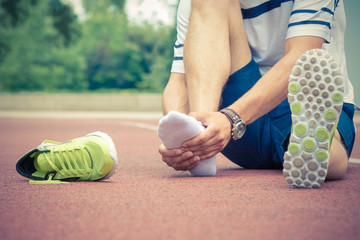Understanding and Managing Plantar Fasciitis
Plantar fasciitis is a common condition involving the support structure along the bottom of your foot. It leads to abnormal thickening and thinning of the plantar fascia, a band of tissue often affected by overuse due to poor foot mechanics, unsupportive footwear, or prolonged time spent on your feet. 
This condition is a frequent cause of foot pain we address at AzOPT, where our physical therapists specialize in diagnosing and treating musculoskeletal issues.
Signs of Plantar Fasciitis
Key symptoms of plantar fasciitis include:
- Pain with touch or pressure near the instep closest to the heel.
- Pain during your first steps in the morning.
- Difficulty flexing the foot upward toward the shin.
This condition often develops gradually without a clear cause. However, common risk factors include:
- Flat feet or high arches.
- Tight hamstrings.
- High body mass index (BMI).
- Activities like running or prolonged standing.
Tips to Manage and Prevent Plantar Fasciitis
If you’re dealing with plantar fasciitis or are at risk, these tips can help you reduce pain and support your recovery:
1. Warm Up Properly
Before work or exercise, warm up your feet with exercises like heel and toe raises, air squats, or marching in place. A simple and effective option is the “100Up” exercise, which you can find on YouTube.
2. Stretch Regularly
Incorporate light stretches before and after activity to warm up your plantar fascia. Yoga poses like downward dog, especially with alternating leg pumps, can be excellent for your feet and calf muscles. For a gentler option, try a seated self-stretch for the plantar fascia.
3. Choose Supportive Footwear
Wear shoes that fit well, provide support, and are not overly soft or hard. Footwear plays a significant role in managing plantar fasciitis, especially on hard floors. Our physical therapists can provide guidance on choosing the right shoes for your specific needs.
4. Maintain a Healthy Weight
Reducing your BMI can decrease the strain on your feet, minimizing pain and improving your overall mobility.
5. Opt for Low-Impact Exercises
Cycling is a fantastic way to maintain your fitness while reducing strain on your feet.
6. Apply Heat for Relief
On high-pain days, applying heat can loosen tight tissues and provide relief.
7. Try Physical Therapy for Plantar Fasciitis
Check out our other blog here for more details on how it can help.
Why Choose AzOPT for Physical Therapy in Arizona?
At AzOPT, our Doctors of Physical Therapy specialize in identifying the root causes of foot pain, including plantar fasciitis. We analyze your movement patterns, such as how you walk or run, to create a personalized treatment plan that eliminates pain and restores function.
If you’re struggling with foot pain, don’t wait—our Arizona-based physical therapists are here to help. Visit one of our locations and experience the difference expert physical therapy can make in your recovery.







